
Investing in Youth: A Demographic Solution for Shrinking Cities
As developed countries deal with aging populations and declining birth rates, numerous cities confront a precarious future characterized by diminishing populations, labor shortages, and weakening local economies. However, fresh research emerging from Japan presents an intriguing remedy: strategically investing in child welfare.
A detailed 15-year investigation led by Dr. Haruka Kato from Osaka Metropolitan University indicates that small and medium-sized Japanese cities which substantially boosted their child welfare investments defied national patterns of population decrease. The study, featured in the Journal of Urban Management, reveals that communities focusing on younger populations experienced significant demographic stability — and in some instances, growth.
Deciphering Japan’s Population Dilemma
Japan stands at the leading edge of global demographic issues. Almost 30% of its residents are over 65 years old, and birth rates have consistently fallen for years. Among the 1,560 small and medium-sized Japanese municipalities examined in the research, over 82% saw a net decline in population from 2007 to 2022.
Yet, Dr. Kato’s findings imply that this trajectory is not set in stone.
Municipalities that raised public spending on child welfare by over ¥50,000 per capita (approximately $330 USD) managed to reverse the trend of depopulation. Conversely, areas that prioritized funding for elderly care and public assistance continued to experience declines.
“This research indicates that reallocating resources to support young families is not only a sound social policy — it’s a potent demographic strategy,” Dr. Kato stated.
What Constitutes Child Welfare Investment?
In the study, child welfare spending encompassed initiatives such as subsidized childcare, complimentary or reduced-cost school meals, housing support for families, and financial incentives for child-rearing. Such programs render it more economical — and appealing — for young families to relocate to smaller towns.
Crucially, Japan’s mild inflation throughout the study period provided researchers with a unique, stable economic environment allowing straightforward year-over-year budget comparisons without complicated inflation adjustments. This established a robust statistical framework for evaluating real-world spending effects.
A Challenge to Traditional Priorities
The findings challenge the traditional perspective of prioritizing support for aging populations in public finance. While the ethical obligation to care for older individuals remains significant, channeling municipal resources into elderly care may inadvertently accelerate community decline when it comes at the cost of younger generations.
By investing in children and families, cities enhance their chances of retaining or drawing in younger inhabitants — a crucial element for revitalizing the workforce, sustaining local economies, and preserving essential social infrastructures like schools, public transport, and healthcare.
Additional Spending Focus Areas of Importance
In addition to child welfare allocations, the study identified other budget categories linked to population stability: street upkeep, effective administrative practices, and rational legislative spending. These investments contribute to improved overall urban livability and governance efficacy, further enhancing a city’s appeal.
Unexpectedly, initiatives aimed at stimulating commerce and industry demonstrated no favorable correlation with population growth in the analyzed cities. This indicates that economic development alone does not reverse demographic decline unless it also addresses the human components crucial for long-term residency and family planning.
Global Implications
Although Japan showcases some of the most pronounced signs of demographic aging, it is not unique in this respect. Research indicates that 20% of European cities and 23% of Chinese municipalities are now encountering population declines. These patterns highlight a worldwide trend toward demographic imbalance unless decisive, innovative policy reforms are implemented.
Dr. Kato’s insights provide a practical response: local governments need to prioritize their resources and initiatives towards retaining and supporting young families, while national governments tackle broader challenges such as pensions, elderly care, and large-scale economic ventures.
A Debate on Demographics and Ethics
The strategic shift of local budgets towards child welfare invites important ethical considerations. Supporting young people should not equate to overlooking older citizens or vulnerable groups reliant on social assistance. Cities must strive for equilibrium, and Dr. Kato believes that this balance is best achieved through a collaborative framework where national governments assume broader responsibilities for the elderly, while municipalities lead initiatives aimed at nurturing families and child development.
Conclusion: Children as a City’s Future Investment
For municipalities worldwide grappling with the harsh reality of demographic decline, Dr. Kato’s study offers optimism — and guidance. Rather than perceiving children as a burden on the system, his findings advocate for viewing them as essential assets for a sustainable urban future.
Investing in child welfare fundamentally represents an investment in a city’s future. It draws in the families that are the bedrock of vibrant communities, sustains local schools and playgrounds, and fosters dynamic, intergenerational neighborhoods.
For cities aiming to stay viable and competitive in an aging society, their most effective long-term strategy may be to focus on their youngest residents.
Further Reading:
– Access the complete study by Dr. Haruka Kato in the Journal of Urban Management.
– Investigate global demographic patterns through resources from the UN Department of Economic and Social Affairs.
– Examine child welfare frameworks in successful cases.